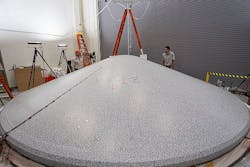Lockheed Martin completes critical testing milestone for NASA JPL's Mars 2020 rover heat shield
The heat shield aerodynamics serve as a "brake" to slow the spacecraft from about 12,000 mph (19,300 kph) so the structure needs to be flawless. As the tenth aeroshell system that Lockheed Martin has produced for NASA, this is one of the largest at 15 feet (4.5 meters) in diameter.
"Our experience building aeroshells for NASA Mars missions does not mean that it is 'easy'," said Neil Tice, Lockheed Martin Mars 2020 Aeroshell program manager. "Tests like this structural test are absolutely essential to ensuring mission success in the long-run."
The static test was conducted on April 25 and was designed to mimic the load that the heat shield will experience during the most extreme part of its journey; the entry phase. To do that, engineers used vacuum pumps to simulate the pressure of approximately 140,000 pounds on the structure. The structure was tested to 120% of the expected flight load to push it to the limit.
For this particular test, the team also integrated a new form of instrumentation. Historically, this test utilizes conventional strain gauges and extensometers to monitor structural response at distinct points during loading. Partnering with NASA Langley Research Center, the team also applied a new tool called Photogrammetry or Digital Image Correlation. This allowed the team to monitor full-field strains and displacements over the entire visible area of the structure in real time. To use this technique, a vinyl wrap, similar to a decal, that has different visual cues (dark random speckles over a white background) was applied to the heat shield. During the test, a set of digital cameras optically monitor any changes in the pattern and generate a three-dimensional map of displacements and surface strains as the applied load increases.
Following this test, the Lockheed Martin team will apply Phenolic Impregnated Carbon Ablator (PICA) thermal protection system tiles to the structure. Once complete and through all environmental testing, the full heat shield will be mated to the backshell in early fall.
The Mars 2020 Project at NASA JPL manages rover development for the Science Mission Directorate at NASA Headquarters in Washington. The NASA Engineering and Safety Center at NASA Langley Research Center provided the photogrammetry support for this test.
Ready to make a purchase? Search the Intelligent Aerospace Buyer's Guide for companies, new products, press releases, and videos
